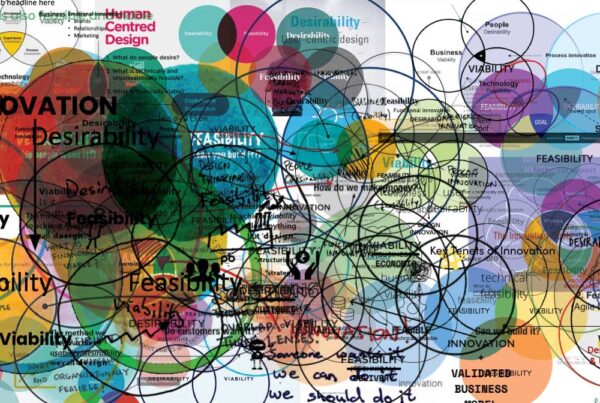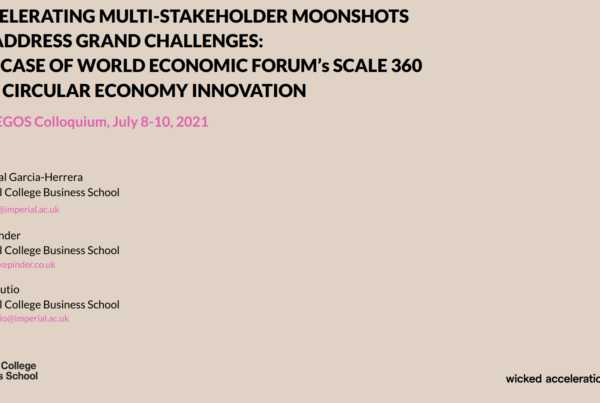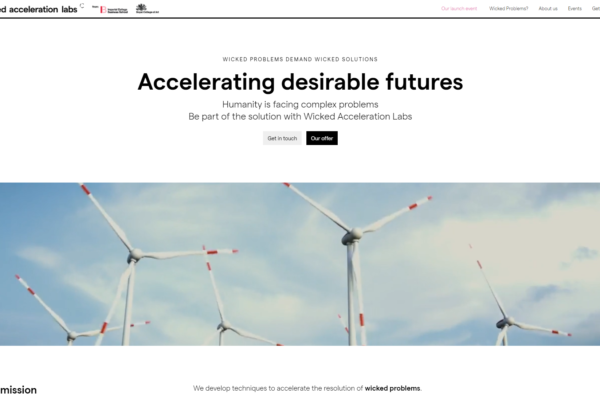Reading time: 25 mins
Abstract
The aim of this article is to shed light on how established innovation processes can be augmented to enable businesses to innovate at the speed necessary for success in the post-coronavirus world. By explicitly visualising what we mean by pursuing value creation using innovation as a learning and knowing vehicle under normal market conditions, I show how value pursuit and creation processes have been disrupted due to the global crisis. Along with discussing why existing innovation methodologies are no longer sufficient to prepare for the future value landscape, I specifically detail how the innovation process can be adapted by incorporating the external macro-environmental analysis tools and frameworks of old. Finally, I discuss how organisations typically respond in the short term regarding innovation types and why these decisions will not be sufficient for survival in the long term.
Introduction
The world is undergoing rapid changes due to coronavirus (COVID-19). The first wave of infection has had a tragic impact on people from all walks of life, with more likely to come. Countries are dealing with COVID-19 in a plethora of individual approaches whilst economies are shrinking to all-time lows with unemployment rates skyrocketing. Nation-state institutions are being stretched to their limits to deal with a crisis with very little preparation, planning and response time.
Immense innovation efforts are ongoing within global pharmaceutical companies to develop vaccines against COVID-19 (with 80 potential candidates undergoing testing at time of writing). For global innovation departments and teams in other industries, budgets were cut and existing projects were postponed or cancelled entirely as they were no longer considered strategically relevant to pursue. Organisations are now desperately fighting to stay afloat by shoring-up the core businesses whilst protecting projects where feasibly possible under the uncertain circumstances.
Many of the thought leadership pieces I’ve seen focus on ‘getting things back to normal’ and how we will ‘quickly bounce back’ at some point in the future. There has been little discussion on how, specifically, organisations should adapt their innovation strategy and processes to deal with COVID-19. In this article, I will provide those specifics. I’ll focus on the role of innovation as we emerge from COVID-19. In particular, I’ll focus on why applying existing innovation capabilities and methodologies to the current crisis will not be enough to keep businesses afloat and economies growing in the longer term. I will discuss the limitations of current innovation management, and explain explicitly how it needs to evolve to meet emergent world needs in the long-term.
This article is split into three parts
- Part I: In Pursuit of Ever-elusive Value
- Part II: The Limitations of Innovation During a Crisis
- Part III: The Innovation Process for Organisations Post-COVID-19
To start with, we first need to understand what it is we’ve been trying to achieve with innovation thus far under normal market conditions. Simply explaining innovation as ‘commercialised ideas’ doesn’t go far enough.
Part I:
In Pursuit of Ever-elusive Value
What do we mean exactly by creating customer value?
Value is a threefold thing. In terms of business markets, it is defined as:
The worth in monetary terms of technical, economic, service and social benefits a customer or company receives in exchange for the price it pays for a market offering (Anderson and Naurus, 1998).
Value, therefore, has three core elements:
- Value is monetary (or other units)
- Value is net benefits (minus costs to obtain)
- Value is transactional (what is obtained in exchange)
If value is this, then how do you go about finding and creating it to support organisational and wider economic growth? Through innovation.
Innovation is ultimately about the intentional pursuit of creating value by commercialising new ideas. When it’s implemented in systematic and repeatable ways, it becomes a core competency and organisational capability that enables sustained growth, on demand.
Our global economy and societies are built upon doing innovation in one form or another. It’s often sporadic. But by prioritizing innovation as a core capability, then it becomes something doable when required, providing you have the right methodologies, tools and mindset to achieve it.
Innovation is ultimately about the intentional pursuit of creating value by commercialising new ideas in a systematic and repeatable ways until it becomes a core competency and organisational capability that enables sustained growth, on demand.
How can we visually conceptualise something as elusive as value creation?
The term value gets thrown around under the unspoken assumption that we all know what it means in roughly the same way. A bit like the word innovation, the term value is used in many contexts in different ways. It has become a meaningless term.
To be clear, the process of value creation is something that happens in our minds individually or collectively and is informed by our previous personal experiences, reasoning processes and contexts.[1]
What this means for organisations seeking to systematically generate new value, is that it is extremely uncertain, a bit like trying to pick up a piece of dark matter. You don’t know what it is conceptually until it is made knowable and tangible by some kind of scientific process to explain it in simple terms. With this in mind, we propose to conceptualise value as follows:
The Innovation Value Landscape
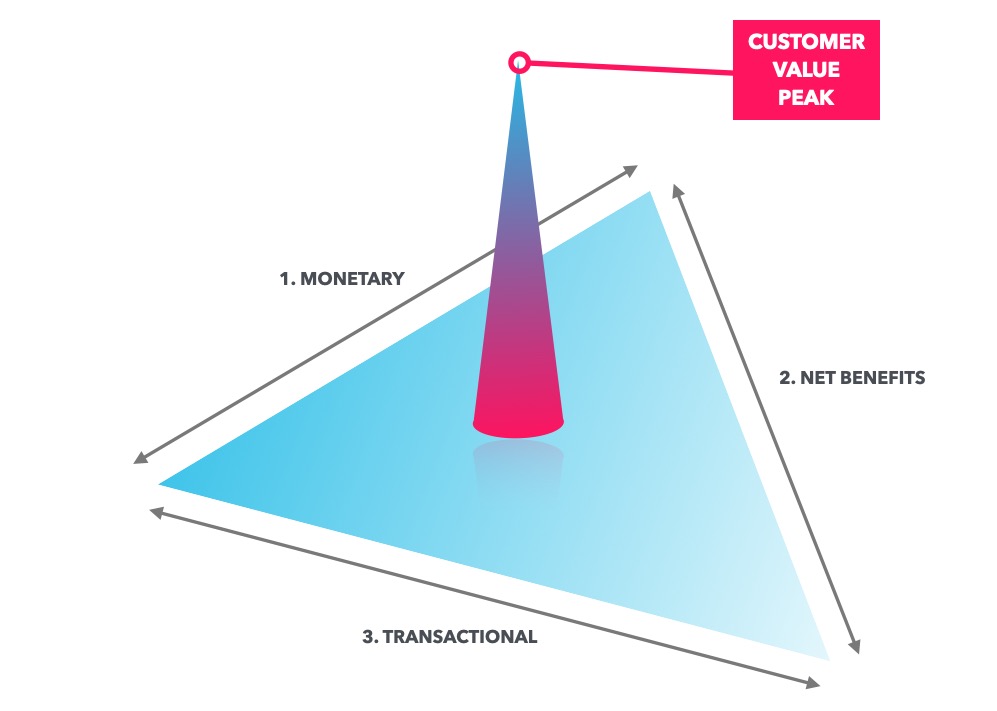
Fig 1. The Innovation Value Landscape: imaginary customer value peaks across the three elements of core value.
The triangular plane in Figure 1 consists of the three value elements: monetary, benefits and transactional as desired from a customer or end-user point of view. In the centre of the plane is an imaginary value peak of specific height and surface area making up its intensity if needs and problems are solved. The value peaks represent achieving customer desirability, business viability and technological feasibility. The higher and broader-based the value peak, the more desirable a concept or solution is by your customers or end-users.
Normally, these value peaks are, of course, invisible to us until they are fully realised as concepts or new products and services in the marketplace. They are made tangible, physical and real because they allow us to transfer meaning, knowledge and ideas through them to achieve a utilitarian job-to-be-done (Carlile, 2002; Christensen et al;, 2017). The innovation process, methodologies and frameworks are designed to empower teams run a structured and repeatable process to ‘enable knowing’ or facilitate teams to find the highest value peaks and thus generate economic and societal impact. Starting at the fuzzy front-end all the way through to product-market fit and scaling phases.
The innovation process, methodologies and frameworks are designed to enable teams to set about structured and repeatable process to ‘enable knowing’ or facilitate teams to find the highest value peaks and thus generate positive economic and societal impact.
In addition to being entirely invisible, as yet unrealised value peaks are continually moving around. They shift left and right, higher and lower, faster and slower as consumer needs preferences evolve, trends emerge, markets crash and white swan events change the landscape at a moment’s notice forever (Taleb, 2007). This is why it is so hard to achieve consistent and sustained disruptive, radical and architectural innovation (Pisano, 2019). Furthermore, there is a huge amount of luck and timing involved in innovation.
The Innovation Value Landscape in Turmoil
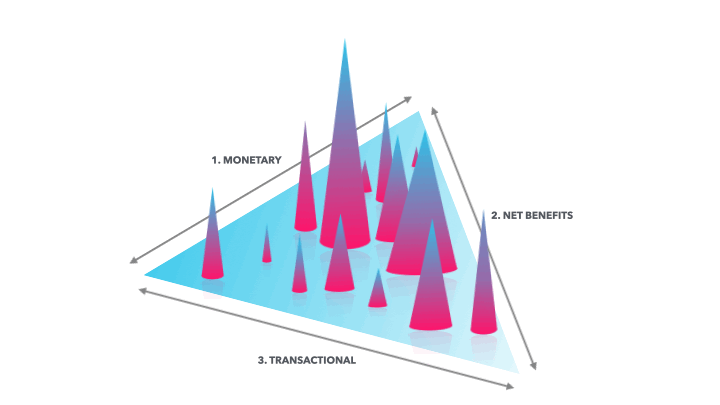
Fig 2. The Innovation Value Landscape: imaginary customer value peaks across the three core value elements
No structured innovation process can account for luck or successful predictions, no matter how much you wish it could. In order to capture value from an emerging and growing value peak you have to anticipate where it will be when it’s commercialised, in addition to running your innovation engine. It’s like trying to hit a moving target that is appearing and disappearing at the same time as moving in all three dimensions at different speeds. Which is one of the many reasons innovation is so hard to consistently achieve.
Why do firms exist? A brief history of innovation thought
Now we know what organisations are trying to achieve through innovation in terms of value creation. Next, why do innovation firms exist? There are many theoretical explanations. Over the past century, thinking has spanned from individuals to corporate organisations, external networks and ecosystems.
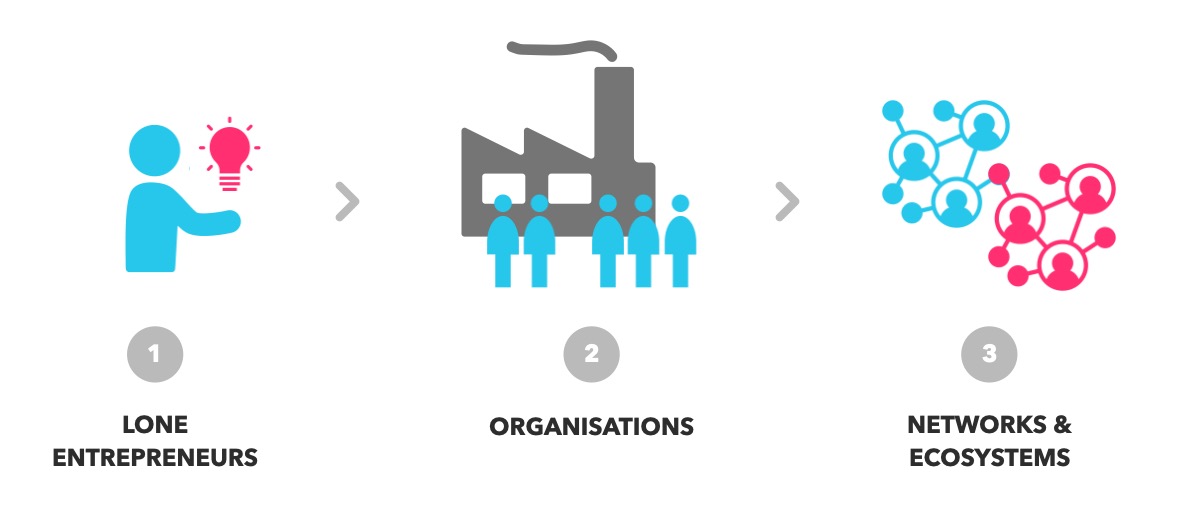
Fig 3. A brief history of innovation thought
What’s more, over the past 100 years analysis has shifted from sole entrepreneurs, towards the emergence of large firms; then to wider networks of collaborators (See Fig 3 above) (Schumpeter, 1942). Explanatory lenses have included resources, transactions, evolution, networks, technologies, culture, knowledge, capabilities, strategies, decisions, structures, institutions, ecologies and ecosystems, among others.[2] These views seek to make predictions and explain why they exist, rather than what they exist to achieve. In essence, they are trying to make it easier to understand when, how and why different organisations of human labour should configure and manage themselves in order to have the best chances of hitting the value peaks.
Widening gap between startups and theory development
One of the many issues facing researchers in predicting and explaining new organisation structures is that the speed of change is now so fast that it is hard (if not impossible) to stay relevant given the lengthy peer-review process. Changes can take years to be published in leading journals. Coupled with this, startups haphazardly apply social and scientific research methods that were tirelessly developed, over many decades, as and when they see fit, with little regard for reproducibility and rigour in their process. One example of which is by applying qualitative analyses to quantitative research approaches.
When it comes to startup teams with limited time and funding, this level of rigour is simply not needed. It slows them down and consumes their limited resources. Startups are trying to get to value peaks as quickly as possible, whilst the academic world is attempting to play catchup by trying to rigorously explain (and predict) the hows and whys. The academic peer review process needs to find ways to speed up theory making in order to stay relevant to practitioners in the field and narrow the practice vs explanatory gap, particularly in times of crisis when the speed of change accelerates exponentially.
We’re all pursuing value creation at speed
Organisations large and small exist in order to find and exploit future visionary value peaks as quickly and accurately as possible. Many innovation approaches are grounded in carefully reviewed theoretical perspectives and applied to value-seeking as innovation capabilities whether consciously realised or not by teams.
Under normal stable market conditions, a handful firms are able to do innovation in a continuous and sustained way, whilst others find new and better ways to seek out and exploit value peaks, leading to the displacement of incumbent firms.
One of the only ways to consistently find value peaks is to quickly locate and exploit many innovations at the same time. A carefully considered scatter-gun portfolio approach, taking aim in a certain direction but not knowing exactly where the end result will be. The trick is to consistently do it quicker, faster and cheaper than your free-market competition. This is one of the reasons why startups are so disruptive to incumbent giants, because they deploy many parallel bootstrapped, agile and resourceful teams, armed with the tools of production.
Startups have the means and sheer numbers to locate new untapped value peaks quicker, faster and cheaper than large organisations. The latter are slowed down by such innovation disadvantages as bureaucracy, silos, culture, short-term thinking, reward structures and goals.
Finding value peaks during severe market disruption
Under normal everyday market circumstances, the rate of shifts and changes of these invisible value peaks is more manageable and locatable as there are fewer external influencing factors continually moving things around. The innovation methodologies used by many leading firms have evolved to meet pre-COVID-19 conditions and are therefore suited to more normal market levels of uncertainty and ambiguity.
However, when a white swan event (a semi-predictable event that is beyond what is normally expected of a situation and has potentially severe consequences) takes place like the COVID-19 outbreak, the whole value landscape is thrown into turmoil. Some peaks that have always been there have vanished overnight. Others are emerging in an instant; while some are quickly shrinking and moving around the plane. All the while others are growing and splitting into further, bigger and smaller value peaks. It’s akin to tectonic plates colliding. This is what true market uncertainty is. Shifting and disappearing value peaks are what we are experiencing now, and we have an unprecedented amount to deal with. Innovation has a big task ahead of it.
Then why is innovation the last thing on the strategic business agenda?
With all this going on, it is hardly surprising that many large, rational organisations are trying to cling to the most stable value peaks because they’ve always been there before. It’s the logical thing to do in the short term, but not necessarily the right thing to do in the long run if you wish to still be relevant in 12 months’ time.
It is hardly surprising that many large, rational organisations are trying to cling to the most stable value peaks because they’ve always been there before.
These organizations are in effect, strategically choosing to stay close to home while pursuing unrelenting incremental innovation (Dewar and Dutton, 1986). Shareholders demand it; Wall Street demands it; and so does the Board of Directors. They wish to continue pursuing safe bets until things blow over. Volatility in the stock market bolsters this thinking, plunging to new lows as a result of high uncertainty and appetite for risk spooking investors (News, 2020). The big assumption here is that things will simply return to the way they were with the economy bouncing back to ‘normal’ again within a year or two. I suspect the social, economic and cultural impacts will be far-reaching, changing the value landscape for a long time to come.
Regarding the search and exploitation of value peaks, going with safe bets is a risky approach that leaves large incumbents firmly open to the well-documented innovator’s dilemma (Christensen, 2011, 2013). Time and time again, I’ve seen successful firms invest in innovation simply too late in their organisational lifecycle, whilst profits and budgets are already in decline.
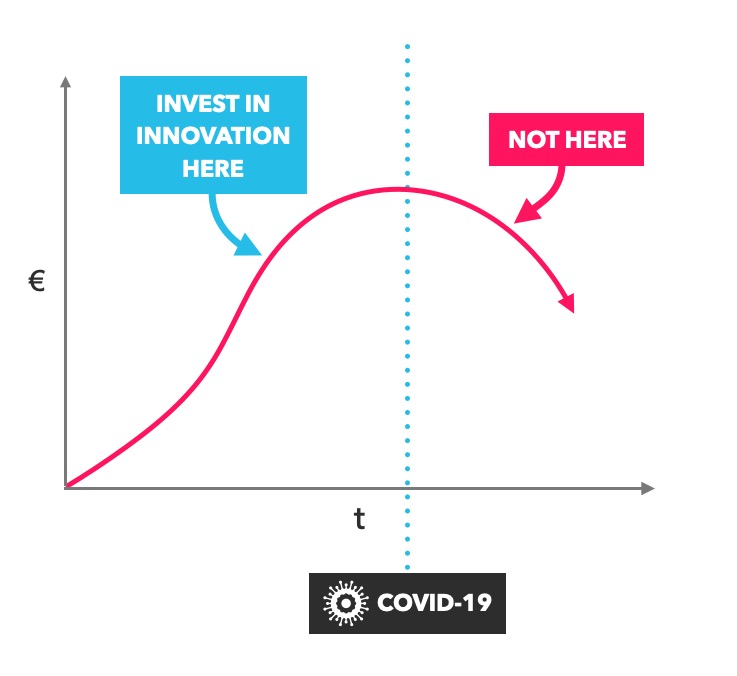
Fig 4. When to invest in innovation capabilities and portfolio approaches
In the eyes of leadership, it is simply not the time to experiment far away from the core business by pursuing entirely new growth opportunities. Which reminds me of a great quote I read:
“One path leads to despair and utter hopelessness. The other to total extinction. Let us pray we have the wisdom to choose correctly”.
(Annie Hall Movie, 1977)
Leaders can find themselves in the most difficult of situations. They may need to choose between cannibalising their own profits or going out of business entirely. The point I wish to make here is that firms wishing to survive (even during stable times), must allocate a proportion of people, time and resources to continually exploring whether or not the current value peaks supporting the organisation still exist or if they are shrinking and disappearing. To do this, firms need to develop new capabilities, ideally built upon existing innovation skills, processes and know-how.
To meet evolving market needs, they need to exploit entirely new value peaks as they begin to emerge by deploying rapid scanning and synthesizing methods, as well as iterative testing and validation. Firms that can successfully manage a balanced set of value-seeking projects across the innovation types in a portfolio will be in the strongest position moving forward in the post-COVID world.
Firms wishing to survive (even during stable times), must allocate a proportion of people, time and resources to continually exploring whether or not the current value peaks supporting the organisation still exist or if they are shrinking and disappearing.
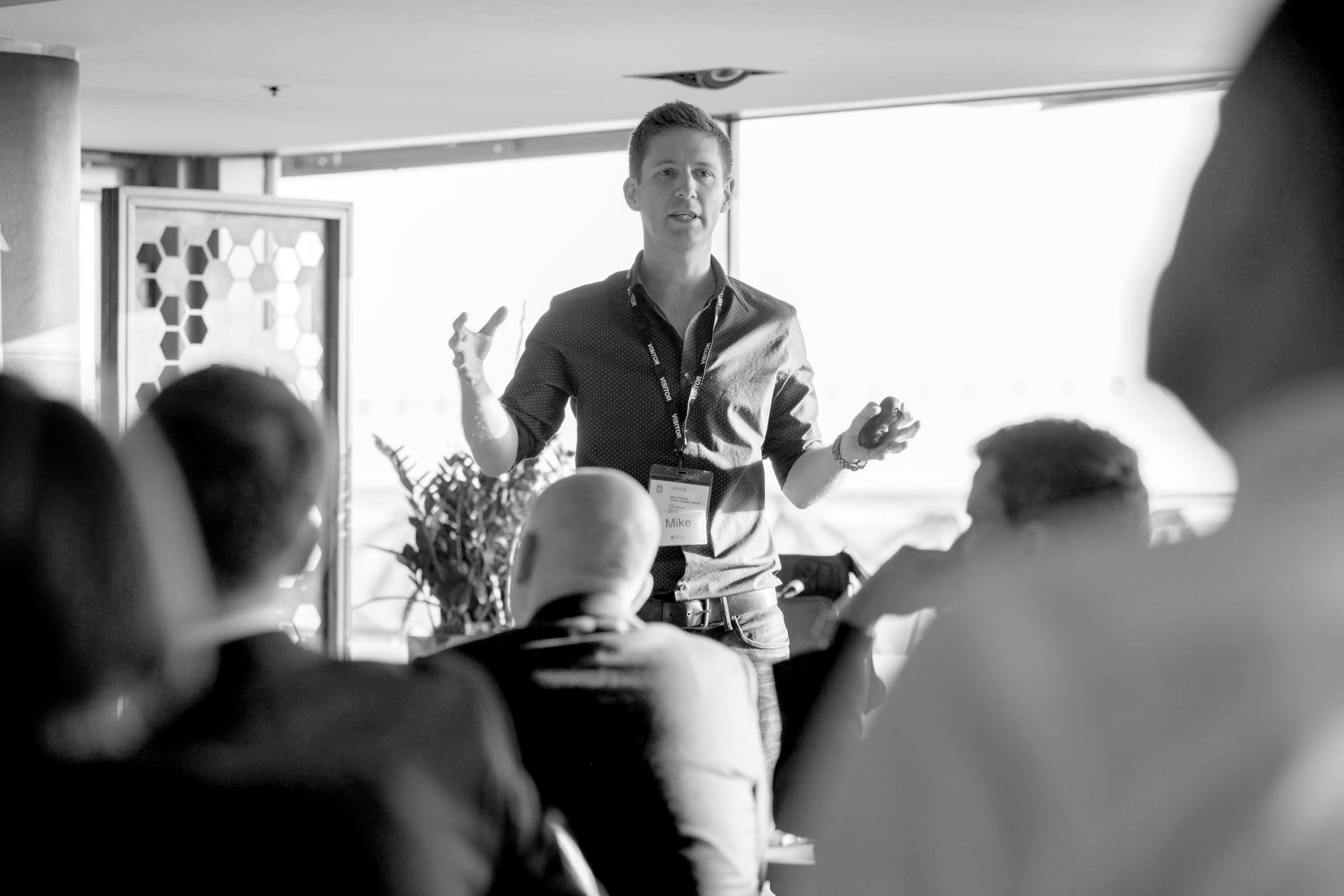
Book Mike for a remote keynote
Inspire your senior leadership and project teams in how to adapt your organisation to succeed with innovation combatting COVID-19.
GET IN TOUCHPart II:
The Limitations of Innovation During a Crisis
Where are our existing innovation capabilities?
‘Hang on!’ I hear you say. ‘Isn’t our new innovation process using Design Thinking, Lean Startup, business model innovation and Agile (invested in so heavily) designed to deal with exactly this kind of uncertainty and ambiguity of COVID-19? The short answer is, yes, they do. But they are suited to more normative levels of consumer-market uncertainty. The COVID global crisis extends the value-seeking landscape more broadly in all dimensions. It is no longer good enough to just gather insights about latent customer needs to start your innovation process. Typically, innovation methods are applied during two- to ten-week iteration cycles within a mostly stable supporting macro environment. During a crisis, consumer needs and desires change drastically overnight. What’s more, their desires are coupled with equally drastic and severe changes in the macro-environment (political, economic, social, environmental and legal domains).
It is no longer good enough to just gather insights about latent customer needs to start your innovation process.
Innovation tools and methods are designed to make sense of shifting and evolving customer needs in normal market evolution speeds, rather than expecting them to make sense of an entire crisis landscape. Ethnographic research methods alone can be too slow and too rigid.
This goes some way to explaining why innovation projects away from home are usually the first to be postponed or cancelled by leadership during such times. However, strong decision-making is needed to make sense of the consumer and wider macro environment being faced right now. Doing so places firms in the best position with the right capabilities to locate, create and capture value in the new emerging landscape once things start getting back to normal again. Research has repeatedly shown that economic growth and firm survival is dependent upon investing in innovation during, not after times of crisis (Paunov, 2012). Furthermore, firms that can emerge with the capability to map the macro-environmental shifts and customer needs and problems will be better equipped to move the fastest when finding and exploiting the most profitable unknown value peaks in the new market landscape ahead.
The role of research and development (R&D) and new technologies in a crisis
In more normal and stable times, new technological paradigms create a toolbox of new possibilities to serve unmet needs in better ways. These open up the near possible, triggering a subset of unrealised value peaks if used at the end of the innovation process (not as a starting point).
A good example here is the ARM microprocessor computing chipset. Originally developed for devices like the ill-fated Apple Newton, ARM chips can now be found in all types of digital devices from smartphones, wearables, Internet of Things devices, cars, airplanes, tablets, hard drives, music players, gaming systems, TVs, navigations systems, alarms, vending machines and many others. As of February 2020, 160 billion ARM chips have sold worldwide (Honan, 2013; ARM, 2020). It is fair to say ARM chips are a true architectural innovation. They have paved the way for new disruptive, radical and incremental innovation types consistently over the past forty years.
We usually apply the innovation process sequentially across three key pillars: customer desirability, business model viability and technological feasibility. However, during genuine architectural innovation like ARM chips, the innovation process in fact starts with technological feasibility, independent of customer desirability entirely. This is because core R&D is needed to open up the near possible consumer value landscape that will in the future comprise new unmet needs and problems. It is the role of R&D to expand the value landscape plane, but it is the role of methods like Design Thinking to figure out what to do with them at the end-consumer and user levels. More often than not, technology firms get into trouble when they over-invest in new technology R&D, only to then release something to market that doesn’t meet any customer needs and value preferences in the right way. See Apple’s Newton device with revolutionary features ahead of its time, but unable to be technically implemented in the right way for actual customer use, such as writing recognition. This caused a great device to ultimately fail in terms of market desirability.
Normally it is enough to understand your customer needs and problems, formulate a way to capture value back for your organisation, then use new and existing technologies to create your validated solution. However, the COVID-19 landscape is about more than needs-and-problems discovery in a relatively stable environment. At the moment (and in the coming years following the predicted recession), the external macro-environment should be held as equally important in driving the creation of new unmet needs, not just on a technology enabling trajectory of the near possible.
To address the new road ahead, the innovation process needs to adapt and meet the needs of organisations seeking to make sense of higher levels of uncertainty and ambiguity from multiple problem domains at once. The startup world continues to be in a strong position as it routinely makes sense of and addresses the evolving value landscape with relative speed and ease. It will be no easy task for established firms. But those that can reconfigure themselves will succeed to the highest levels.
Part III:
The Innovation Process for Organisations Post-COVID-19
So far, we have looked at why organisations exist in relation to creating value types. We’ve looked at how value is conceptualised and uncovered when solving customer needs and problems during periods of environmental stability. We’ve also looked at how the global COVID-19 pandemic has shifted the value landscape. We will now look at another, equally important dimension that has not seen much light for the past twenty years.
Moving forward, organisations need to equally and continually make sense of two key insight domains:
1. The rapidly evolving macro-environment
2. Radically shifting consumer/customer needs and problems
How should organisations adapt and transition to a post-COVID-19 world to achieve new value creation throughout the innovation process?
Firms will need to develop two new sense-making competencies.
1. Deploying a continual external scanning capability
2. More rapid ethnographic empathy research methods
New technology R&D is hard and takes time to do safely. We can’t rely upon R&D alone to provide solutions. We’re facing life and death challenges. We need solutions now.
Dynamic capabilities are routines to learn new sensemaking routines within organisations. They are required to allow firms to find external knowledge and insights about the outside world. Once found, they need to be quickly absorbed across organisational boundaries to build upon within innovation teams. Spanning from the outside world to internal, we need remote teams who can quickly deliver the right value to solve new unmet needs (Cohen and Levinthal, 1990; Teece, Pisano and Shuen, 1997). Organisations don’t have time, money or luxury of not invented here syndrome, especially during a crisis. Defined as the dysfunction where external solutions to problems are rejected in favour of internally developed solutions (Katz and Allen, 1982). Solutions need to quickly come from where ever possible to meet unmet value peak needs and problems.
1. Developing a continuous external scanning capability
During my studies in international business and management, much focus was given to industrial organisation economics in understanding the theory of the firm from a macro-environmental perspective for strategic decision making. Authors from the 1980s and 1990s such as Kotler, Porter, Tirole, Scherer, Shapiro, Maslow, et al. As we’ve seen earlier, standard management practice has more recently shifted to understanding networks and ecosystems of value exchange as a source of competitive advantage.
Examples of industrial organisation economics tools and frameworks:
- 5 Forces Framework
- PESTEL Analysis
- SCLEPT Analysis
- Issues Priority Matrix
- Tows Model
- Five Product Levels
- Ansoff’s Growth Matrix
- Value Chain Analysis
- Hofstede & Trompenaar’s Cultural Value Dimensions
- Value Network Analysis
- Strategy Canvas
- Life Cycle Model
- Issues Priority Matrix
- Competitive Rivalry Analysis
To make sense of the pandemic impacts on the emerging value landscape in the coming years, it is vital to re-train your innovation teams in more traditional (perhaps seen as outdated) tools and frameworks.
Sometimes you have to look back to move forward. A retrospective look back to the shock of the old to solve the now (Edgerton, 2008). A story well told in the movie Hidden Figures in 2017, whereby Katherine Johnson, a NASA research mathematician, had to refer back to ancient mathematics using an ancient approximation technique called Euler’s Method in order to solve the vastly complex Mercury Mission orbital mechanics re-entry calculations for safe astronaut return (Meyers, 2017; Intmath, 2018).
It is important to stand on the shoulders of giants during significant uncertainty and volatility to solve problems quickly and effectively. Our body of knowledge serves specific purposes and can help make sense of what is happening outside your organisation to inform effective management and decision making. What’s more, older tools can now easily be adapted for use in distributed digital innovation teams using tools such as Mural and Miro remotely for innovation project sprints; something that was not possible when they were first introduced.
An up-to-date understanding of what is happening in the macro-environment is more crucial now than before, particularly as we are under lockdown for months at a time with no sense of the outside world. Organisations need to empower their innovation teams with this reincarnated external scanning capability because they are not part of the current iterative customer-centric innovation process applied within organisations today. The future of work will very likely continue to occur remotely, so teams need to intimately understand what is happening out there by capturing and absorbing changes in market conditions, competition, government interventions, fiscal policies, protectionism, legal frameworks and the like as they emerge.
Organisations need to empower their innovation teams with a reincarnated external scanning capability because they are not part the current iterative customer-centric innovation process applied within organisations today.
This needs to happen on a weekly and daily rhythm basis in the short-to-mid terms, continually updating the tools and frameworks as key changes and trends emerge. Innovation teams looking for radical and disruptive triggers and insights for new innovation projects should be carefully analysing and documenting what is happening externally in order to feed and uncover key common insights triangulated from multiple stakeholder perspectives. In effect, we need to devote as much importance to understanding the external environment as we would normally give to understanding customer needs and problems alone. These external insights should then be used in combination with more traditional innovation methodologies, such as Design Thinking, lean startup and business model innovation (in a modified form). Doing so will enable you to address COVID-19-related business challenges for your organisation.
Equal importance needs to be given to understanding the external environment as much as we would normally devote to understanding customer needs and problems alone.
2. Building rapid ethnographic empathy research methods
Many world-leading organisations have been investing in iterative innovation methodologies over the past twenty years, accelerated largely by competition; the speed and agility of the startup world; the rate of technological change; and the democratisation of the means of production through digitalisation. The good news is that a customer-centric innovation process is as important now as it always has been; perhaps more so. In addition to understanding the external environment, we need to deprioritise Design Thinking, Lean Startup and business model innovation so that they run in parallel with understanding changes in the macro world in order to trigger the innovation process. This also needs to happen quicker than ever before.
Perhaps for the first time in its history, the successful application of Design Thinking is dependent upon looking back at and incorporating older methodologies and frameworks to make it effective for organisations addressing the COVID-19 challenges we’re facing today.
We are lucky enough to have the digital collaboration tools to get close to our customers (even under a pandemic lockdown) with a plethora of tools at our fingertips at low cost or free. It is easier now than ever before. Millions of consumers, users and employees working from home or under furlough schemes globally. We can quickly deploy traditional research methods in remote form. These may include contextual qualitative interviews, cultural probes, remote home-shadow, focus groups, participant observation and large-scale quantitative surveys.
Perhaps for the first time in its history, the successful application of Design Thinking is dependent upon looking back at and incorporating older methodologies and frameworks to make it effective for organisations addressing the COVID-19 challenges we’re facing today.
Fortunately for innovation purposes, the qualitative research methods required during the empathise phase of the innovation process are still achievable thanks to digital technology. Innovation teams do not have the excuse that they can’t get close enough to customers to understand their needs and problems during lockdown and beyond.
Combining insights for innovation
Once your teams have uncovered new opportunity areas from both the macro-environment and outside of your existing markets, you will be able to spot the overlaps in problems and need and determine jobs-to-be-done that did not exist prior. Macro-world and customer-driven insight domains should be fed into your current innovation capability. Firstly, by defining challengingly broad how-might-we (HMW) statements for your organisation. Secondly, by sending your teams more divergently across adjacent and new markets which may provide product and service areas that you might not otherwise have been given the strategic green light to pursue.
How the innovation process needs adapting to meet the challenges of a post-COVID-19 world
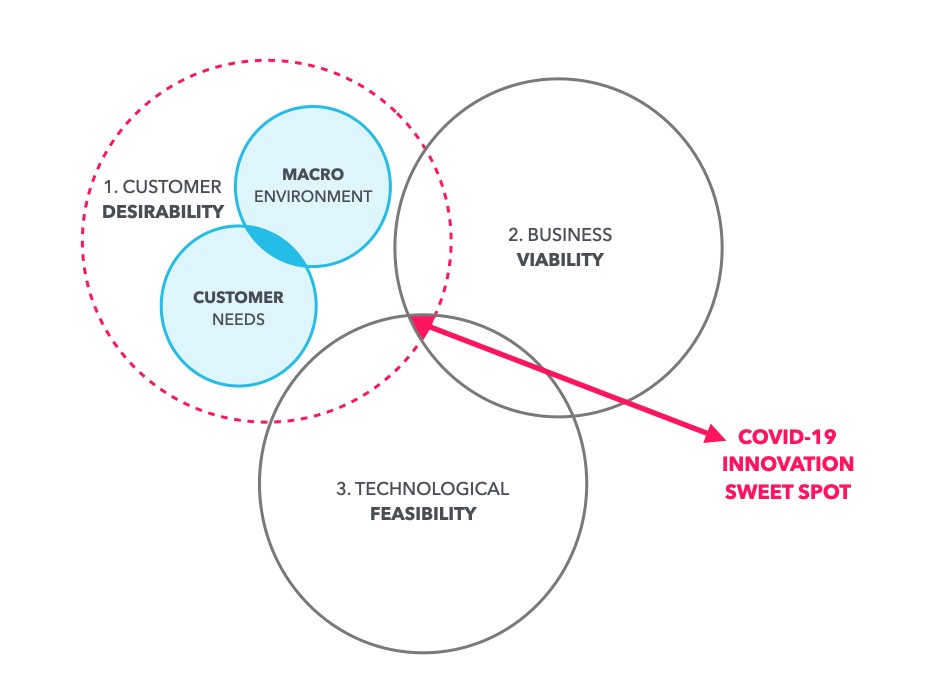
Fig 5. How organisations need to adapt the innovation process to effectively deal with COVID-19 challenges ahead
Summary
In order to survive in the short-term crisis, organisations and their leaders need to shore up their businesses and protect the core revenue streams. In the mid-to-longer term, organisations need to internalise and harness enhanced uncertainty as part of their innovation strategies, realising that the value landscape will look very different in the months and years ahead. Business-and innovation-level strategies need to support this by making the confident decision to allocate a proportion of people, time and resources to disrupting the core of their own business, now. Once this decision has been made, relearn, digitise and deploy generations-old frameworks to your strategic innovation project teams to help quickly understand the macro-environment. Improved capabilities that enhance existing customer-centric knowhow in terms of speed, breadth and frequency need to be used.
Organisations must make the strategic decision to allocate a proportion of people, time and resources, specifically aimed at disrupting the core business, now.
Once both pieces of the COVID-capability are in place, your organisation will have effectively developed an external macro-environment scanning radar, coupled with a deep and extensive understanding of your target market both beyond your existing segments and into new markets entirely. Using these two insight perspectives in parallel will ensure that a proportion of your resources are spent solving the right disruptive and radical customer needs, independent of your existing business. You will then be in a position to identify nascent value peaks before they have become fully saturated towers. Identifying value peaks quickly and early will provide emerging kernels for your organisation’s survival post-pandemic and beyond.
Stay safe.
Written in quarantine in Belgium.
Mike

Book Mike for a remote keynote
Inspire your senior leadership and project teams in how to adapt your organisation to succeed with innovation combatting COVID-19.
GET IN TOUCH
This article was edited in collaboration with Alexandra Sutton. A freelance SEO & UX copywriter, she’s helped such brands as Board of Innovation, Toyota and Pioneer DJ tell stories that strike a chord. Looking for the right words? Get in touch with her on LinkedIn to find out how she can help.
Footnotes
[1] This topic has significant philosophical implications, based upon a mixture of subjective, objective ontologies among other viewpoints and lenses. For further reading on this, I recommend a booked titled, Creative Research: The Theory and Practice of Research for the Creative Industries (Collins, 2010).
[2] Further reading: (Schumpeter, 1942; Hannan and Freeman, 1977; Williamson, 1979; DiMaggio and Powell, 1983; Wernerfelt, 1984; Kogut and Zander, 1992; Denison and Mishra, 1995; Burgelman and Grove, 1996; Podolny, Stuart and Hannan, 1996; Tushman, Anderson and O’Reilly III, 1997; Teece, Pisano and Shuen, 1997; Gulati, 1998; Sherman, Kashlak and Joshi, 1998; Santos and Eisenhardt, 2009).
References
- Allen, W. (1977) Annie Hall. United Artists. Available at: https://www.imdb.com/title/tt0075686/?ref_=fn_al_tt_1.
- Anderson, J. C. and Narus, J. A. (1998) ‘Business marketing: understand what customers value.’, Harvard business review.
- ARM (2020) Processor IP | IoT | AI | Arm – Arm. Available at: https://www.arm.com/company (Accessed: 20 April 2020).
- Burgelman, R. A. and Grove, A. S. (1996) ‘Strategic Dissonance’, California Management Review. doi: 10.2307/41165830.
- Carlile, P. R. (2002) ‘A pragmatic view of knowledge and boundaries: Boundary objects in new product development’, Organization Science, 13(4), pp. 442-455+456. doi: 10.1287/orsc.13.4.442.2953.
- Christensen, C. (2013) The Innovator’s Solution: Creating and Sustaining Successful Growth. 1 edition. Harvard Business Review Press.
- Christensen, C. M. (2011) The Innovator’s Dilemma, The Innovator’s Dilemma. doi: 10.15358/9783800642816.
- Christensen, C. M. et al. (2016) ‘Know your customers’ “jobs to be done”’, Harvard Business Review.
- Cohen, W. M. and Levinthal, D. A. (1990) ‘Absorptive Capacity: A New Perspective on Learning and Innovation’, Administrative Science Quarterly. doi: 10.2307/2393553.
- Collins, H. (2010) Creative Research: The Theory and Practice of Research for the Creative Industries (Required Reading Range). London: AVA Publishing.
- Denison, D. R. and Mishra, A. K. (1995) ‘Toward a Theory of Organizational Culture and Effectiveness’, Organization Science. doi: 10.1287/orsc.6.2.204.
- Dewar, R. D. and Dutton, J. E. (1986) ‘The Adoption of Radical and Incremental Innovations: An Empirical Analysis’, Management Science, 32(11), pp. 1422–1433. Available at: http://www.jstor.org/discover/10.2307/2631501?uid=3738032&uid=2&uid=4&sid=21100971241613.
- DiMaggio, P. J. and Powell, W. W. (1983) ‘The Iron Cage Revisited: Institutional Isomorphism and Collective Rationality in Organizational Fields’, American Sociological Review. doi: 10.2307/2095101.
- Edgerton, D. (2008) The Shock of the Old: Technology and Global History Since 1900. London: Profile Books Ltd.
- Gulati, R. (1998) ‘Alliances and networks’, Strategic Management Journal. doi: 10.1002/(SICI)1097-0266(199804)19:4<293::AID-SMJ982>3.0.CO;2-M.
- Hannan, M. T. and Freeman, J. (1977) ‘The Population Ecology of Organizations’, American Journal of Sociology. doi: 10.1086/226424.
- Honan, M. (2013) Remembering the Apple Newton’s Prophetic Failure and Lasting Impact | WIRED, Wired.com. Available at: https://www.wired.com/2013/08/remembering-the-apple-newtons-prophetic-failure-and-lasting-ideals/ (Accessed: 20 April 2020).
- Intmath (2018) 11. Euler’s Method – a numerical solution for Differential Equations. Available at: https://www.intmath.com/differential-equations/11-eulers-method-des.php (Accessed: 22 April 2020).
- Katz, R. and Allen, T. J. (1982) ‘Investigating the Not Invented Here (NIH) syndrome: A look at the performance, tenure, and communication patterns of 50 R & D Project Groups’, R&D Management. Blackwell Publishing Ltd, 12(1), pp. 7–20. doi: 10.1111/j.1467-9310.1982.tb00478.x.
- Kogut, B. and Zander, U. (1992) ‘Knowledge of the firm, combinative capabilities, and the replication of technology’, Organization Science, 3(3).
- Meyers, C. (2017) Exploring the Math in ‘Hidden Figures’ | Inside Science. Available at: https://www.insidescience.org/news/exploring-math-hidden-figures (Accessed: 22 April 2020).
- News, B. (2020) Coronavirus: Stock markets suffer worst quarter since 1987 – BBC News, BBC News. Available at: https://www.bbc.com/news/business-52113841?intlink_from_url=https://www.bbc.com/news/topics/cgdzpg5yvdvt/stock-markets&link_location=live-reporting-story (Accessed: 20 April 2020).
- Paunov, C. (2012) ‘The global crisis and firms’ investments in innovation’, Research Policy, 41(1), pp. 24–35. doi: 10.1016/j.respol.2011.07.007.
- Pisano, G. (2019) Creative Construction: The DNA of Sustained Innovation. PublicAffairs.
- Podolny, J. M., Stuart, T. E. and Hannan, M. T. (1996) ‘Networks, knowledge, and niches: Competition in the worldwide semiconductor industry, 1984-1991’, American Journal of Sociology. doi: 10.1086/230994.
- Santos, F. and Eisenhardt, K. (2009) ‘Constructing markets and shaping boundaries: Entrepreneurial power in nascent fields’, Academy of Management Journal. doi: 10.5465/AMJ.2009.43669892.
- Schumpeter, J. A. (1942) Capitalism, Socialism and Democracy. London: Unwin.
- Sherman, H. D., Kashlak, R. J. and Joshi, M. P. (1998) ‘The effect of the board and executive committee characteristics on the degree of internationalization’, Journal of International Management. doi: 10.1016/S1075-4253(98)00017-9.
- Taleb, N. N. (2007) The Black Swan: The Impact of the Highly Improbable (Random House, 2007), The Review of Austrian Economics. doi: 10.1007/s11138-008-0051-7.
- Teece, D. J., Pisano, G. and Shuen, A. (1997) ‘Dynamic capabilities and strategic management’, Strategic Management Journal, 18(7), pp. 509–533.
- Tushman, M. L., Anderson, P. C. and O’Reilly III, C. a (1997) ‘Technology cycles, innovation streams, and ambidextrous organizations: organization renewal through innovation streams and strategic change’, Managing strategic innovation and change. doi: 10.1093/icc/dtq040.
- Wernerfelt, B. (1984) ‘A resource‐based view of the firm’, Strategic Management Journal. doi: 10.1002/smj.4250050207.
- Williamson, O. E. (1979) ‘Transaction-Cost Economics: The Governance of Contractual Relations’, Journal of Law and Economics, (22), pp. 233–262.



